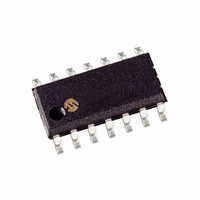PIC16F616-I/SL Microchip Technology, PIC16F616-I/SL Datasheet - Page 51

PIC16F616-I/SL
Manufacturer Part Number
PIC16F616-I/SL
Description
IC PIC MCU FLASH 2KX14 14SOIC
Manufacturer
Microchip Technology
Series
PIC® 16Fr
Datasheets
1.PIC12F609T-ISN.pdf
(26 pages)
2.PIC16F616T-ISL.pdf
(4 pages)
3.PIC16F616T-ISL.pdf
(214 pages)
4.PIC16F616T-ISL.pdf
(8 pages)
5.PIC16F616-ESL.pdf
(180 pages)
Specifications of PIC16F616-I/SL
Program Memory Type
FLASH
Program Memory Size
3.5KB (2K x 14)
Package / Case
14-SOIC (3.9mm Width), 14-SOL
Core Processor
PIC
Core Size
8-Bit
Speed
20MHz
Peripherals
Brown-out Detect/Reset, POR, PWM, WDT
Number Of I /o
11
Ram Size
128 x 8
Voltage - Supply (vcc/vdd)
2 V ~ 5.5 V
Data Converters
A/D 8x10b
Oscillator Type
Internal
Operating Temperature
-40°C ~ 85°C
Processor Series
PIC16F
Core
PIC
Data Bus Width
8 bit
Data Ram Size
128 B
Maximum Clock Frequency
20 MHz
Number Of Programmable I/os
11
Number Of Timers
3
Maximum Operating Temperature
+ 85 C
Mounting Style
SMD/SMT
3rd Party Development Tools
52715-96, 52716-328, 52717-734
Development Tools By Supplier
PG164130, DV164035, DV244005, DV164005, PG164120, ICE2000
Minimum Operating Temperature
- 40 C
On-chip Adc
10 bit, 8 Channel
Lead Free Status / RoHS Status
Lead free / RoHS Compliant
For Use With
MCP1631RD-DCPC1 - REF DES BATT CHARG OR LED DRIVERAC162083 - HEADER MPLAB ICD2 PIC16F616 8/14
Eeprom Size
-
Connectivity
-
Lead Free Status / Rohs Status
Lead free / RoHS Compliant
Available stocks
Company
Part Number
Manufacturer
Quantity
Price
Company:
Part Number:
PIC16F616-I/SL
Manufacturer:
MICROCHIP
Quantity:
400
Company:
Part Number:
PIC16F616-I/SL
Manufacturer:
Microchip Technology
Quantity:
45 197
Part Number:
PIC16F616-I/SL
Manufacturer:
MICROCHIP
Quantity:
20 000
6.7
The Timer1 register pair (TMR1H:TMR1L) increments
to FFFFh and rolls over to 0000h. When Timer1 rolls
over, the Timer1 interrupt flag bit of the PIR1 register is
set. To enable the interrupt on rollover, you must set
these bits:
• TMR1IE bit of the PIE1 register
• PEIE bit of the INTCON register
• GIE bit of the INTCON register
• T1SYNC bit of the T1CON register
• TMR1CS bit of the T1CON register
• T1OSCEN bit of the T1CON register (can be set)
The interrupt is cleared by clearing the TMR1IF bit in
the Interrupt Service Routine.
6.8
Timer1 can only operate during Sleep when setup in
Asynchronous Counter mode. In this mode, an external
crystal or clock source can be used to increment the
counter. To set up the timer to wake the device:
• TMR1ON bit of the T1CON register must be set
• TMR1IE bit of the PIE1 register must be set
• PEIE bit of the INTCON register must be set
The device will wake-up on an overflow and execute
the next instruction. If the GIE bit of the INTCON
register is set, the device will call the Interrupt Service
Routine (0004h).
6.9
The ECCP module uses the TMR1H:TMR1L register
pair as the time base when operating in Capture or
Compare mode.
FIGURE 6-2:
© 2007 Microchip Technology Inc.
Note:
Note 1: Arrows indicate counter increments.
T1CKI = 1
when TMR1
Enabled
T1CKI = 0
when TMR1
Enabled
2: In Counter mode, a falling edge must be registered by the counter prior to the first incrementing rising edge of the clock.
Timer1 Interrupt
Timer1 Operation During Sleep
ECCP Capture/Compare Time Base
(PIC16F616/16HV616 Only)
The TMR1H:TTMR1L register pair and the
TMR1IF bit should be cleared before
enabling interrupts.
TIMER1 INCREMENTING EDGE
PIC16F610/616/16HV610/616
Preliminary
In Capture mode, the value in the TMR1H:TMR1L
register pair is copied into the CCPR1H:CCPR1L
register pair on a configured event.
In Compare mode, an event is triggered when the value
CCPR1H:CCPR1L register pair matches the value in
the TMR1H:TMR1L register pair. This event can be a
Special Event Trigger.
For more information, see Section 10.0 “Enhanced
Capture/Compare/PWM (With Auto-Shutdown and
Dead Band) Module (PIC16F616/16HV616 Only)”.
6.10
When the ECCP is configured to trigger a special
event, the trigger will clear the TMR1H:TMR1L register
pair. This special event does not cause a Timer1 inter-
rupt. The ECCP module may still be configured to gen-
erate a ECCP interrupt.
In this mode of operation, the CCPR1H:CCPR1L register
pair effectively becomes the period register for Timer1.
Timer1 should be synchronized to the F
Special Event Trigger. Asynchronous operation of
Timer1 can cause a Special Event Trigger to be missed.
In the event that a write to TMR1H or TMR1L coincides
with a Special Event Trigger from the ECCP, the write
will take precedence.
For more information, see Section 10.2.4 “Special
Event Trigger”.
6.11
The same clock used to increment Timer1 can also be
used to synchronize the comparator output. This
feature is enabled in the Comparator module.
When using the comparator for Timer1 gate, the
comparator output should be synchronized to Timer1.
This ensures Timer1 does not miss an increment if the
comparator changes.
For
“Synchronizing Comparator C2 Output to Timer1”.
more
ECCP Special Event Trigger
(PIC16F616/16HV616 Only)
Comparator Synchronization
information,
see
DS41288C-page 49
OSC
Section 8.8.2
to utilize the



















